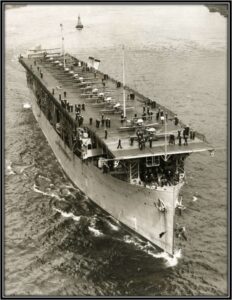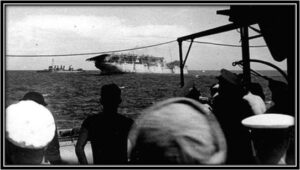Good morning fellow ECAHF’ers. Happy Leap Year in two days! Speaking of leaping, we’re going to leap between yesterday’s aviation history and today’s aviation history in our “Tuesday Twofer”. First, today’s aviation history.
Being the very first at something in our great, big country is a goal many might pursue. But few achieve it. But two firsts? Almost impossible! The USS Langley, in fact, had two firsts…she was America’s first aircraft carrier…a high honor indeed.
But her “second first” was inauspicious. She was the first US aircraft carrier sunk during WWII, just slightly less than three months after the Japanese attack on Pearl Harbor.
Eighty-two years ago, today, on February 27, 1942, the U.S. Navy’s first aircraft carrier, the Langley, is sunk by Japanese warplanes (with a little help from U.S. destroyers), and all of its 32 aircraft are lost.
From History.com: “The Langley was launched in 1912 as the naval collier (coal transport ship) Jupiter. After World War I, the Jupiter was converted into the Navy’s first aircraft carrier and rechristened the Langley, after aviation pioneer Samuel Pierpont Langley. It was also the Navy’s first electrically propelled ship, capable of speeds of 15 knots. On October 17, 1922, Lt. Virgil C. Griffin piloted the first plane, a VE-7-SF, launched from the Langley's decks. Although planes had taken off from ships before, it was nevertheless a historic moment. After 1937, the Langley lost the forward 40 percent of her flight deck as part of a conversion to seaplane tender, a mobile base for squadrons of patrol bombers.

“On December 8, 1941, the Langley was part of the Asiatic Fleet in the Philippines when the Japanese attacked. She immediately set sail for Australia, arriving on New Year’s Day, 1942. On February 22, commanded by Robert P. McConnell, the Langley, carrying 32 Warhawk fighters, left as part of a convoy to aid the Allies in their battle against the Japanese in the Dutch East Indies.
“On February 27, the Langley parted company from the convoy and headed straight for the port at Tjilatjap, Java. About 74 miles south of Java, the carrier met up with two U.S. escort destroyers when nine Japanese twin-engine bombers attacked. Although the Langley had requested a fighter escort from Java for cover, none could be spared. The first two Japanese bomber runs missed their target, as they were flying too high, but the Langley's luck ran out the third time around and it was hit three times, setting the planes on her flight deck aflame. The carrier began to list. Commander McConnell lost his ability to navigate the ship. McConnell ordered the Langley abandoned, and the escort destroyers were able to take his crew to safety. Of the 300 crewmen, only 16 were lost. The destroyers then sank the Langley before the Japanese were able to capture it.”

And for the second of our “Tuesday Twofer” vignettes, yesterday in 1935, on February 26th according to History.com, “Nazi leader Adolf Hitler signed a secret decree authorizing the founding of the Reich Luftwaffe as a third German military service to join the Reich army and navy. In the same decree, Hitler appointed Hermann Goering, a German air hero from World War I and high-ranking Nazi, as commander in chief of the new German air force.
“The Versailles Treaty that ended World War I prohibited military aviation in Germany, but a German civilian airline—Lufthansa—was founded in 1926 and provided flight training for the men who would later become Luftwaffe pilots. After coming to power in 1933, Nazi leader Adolf Hitler began to secretly develop a state-of-the-art military air force and appointed Goering as German air minister. (During World War I, Goering commanded the celebrated air squadron in which the great German ace Manfred von Richthofen–“The Red Baron”–served.) In February 1935, Hitler formally organized the Luftwaffe as a major step in his program of German rearmament.
“The Luftwaffe was to be un-camouflaged step-by-step so as not to alarm foreign governments, and the size and composition of Luftwaffe units were to remain secret as before. However, in March 1935, Britain announced it was strengthening its Royal Air Force (RAF), and Hitler, not to be outdone, revealed his Luftwaffe, which was rapidly growing into a formidable air force.
“As German rearmament moved forward at an alarming rate, Britain and France protested but failed to keep up with German war production. The German air fleet grew dramatically, and the new German fighter–the Me-109–was far more sophisticated than its counterparts in Britain, France, or Russia. The Me-109 was bloodied during the Spanish Civil War; Luftwaffe pilots received combat training as they tried out new aerial attack formations on Spanish towns such as Guernica, which suffered more than 1,000 killed during a brutal bombing by the Luftwaffe in April 1937.

“The Luftwaffe was configured to serve as a crucial part of the German blitzkrieg, or “lightning war”–the deadly military strategy developed by General Heinz Guderian. As German panzer divisions burst deep into enemy territory, lethal Luftwaffe dive-bombers would decimate the enemy’s supply and communication lines and cause panic. By the outbreak of World War II in September 1939, the Luftwaffe had an operational force of 1,000 fighters and 1,050 bombers.
“First Poland and then Denmark, Norway, Holland, Belgium, and France fell to the blitzkrieg. After the surrender of France, Germany turned the Luftwaffe against Britain, hoping to destroy the RAF in preparation for a proposed German landing. However, in the epic air battle known as the Battle of Britain, the outnumbered RAF fliers successfully resisted the Luftwaffe, relying on radar technology, their new, highly maneuverable Spitfire aircraft, bravery, and luck. For every British plane shot down, two German warplanes were destroyed. In the face of British resistance, Hitler changed strategy in the Battle of Britain, abandoning his invasion plans and attempting to bomb London into submission. However, in this campaign, the Luftwaffe was hampered by its lack of strategic, long-range bombers, and in early 1941 the Battle of Britain ended in failure.
“Britain had handed the Luftwaffe its first defeat. Later that year, Hitler ordered an invasion of the USSR, which after initial triumphs turned into an unqualified disaster. As Hitler stubbornly fought to overcome Russia’s bitter resistance, the depleted Luftwaffe steadily lost air superiority over Europe in the face of increasing British and American air attacks. By the time of the D-Day invasion of Normandy in June 1944, the Luftwaffe air fleet was a skeleton of its former self.”
Onward and upward!
Barry Fetzer
ECAHF Historian
